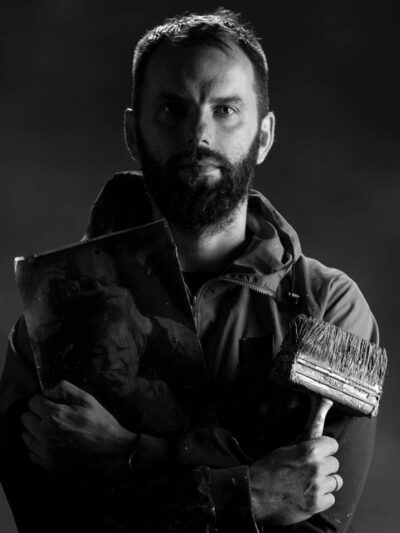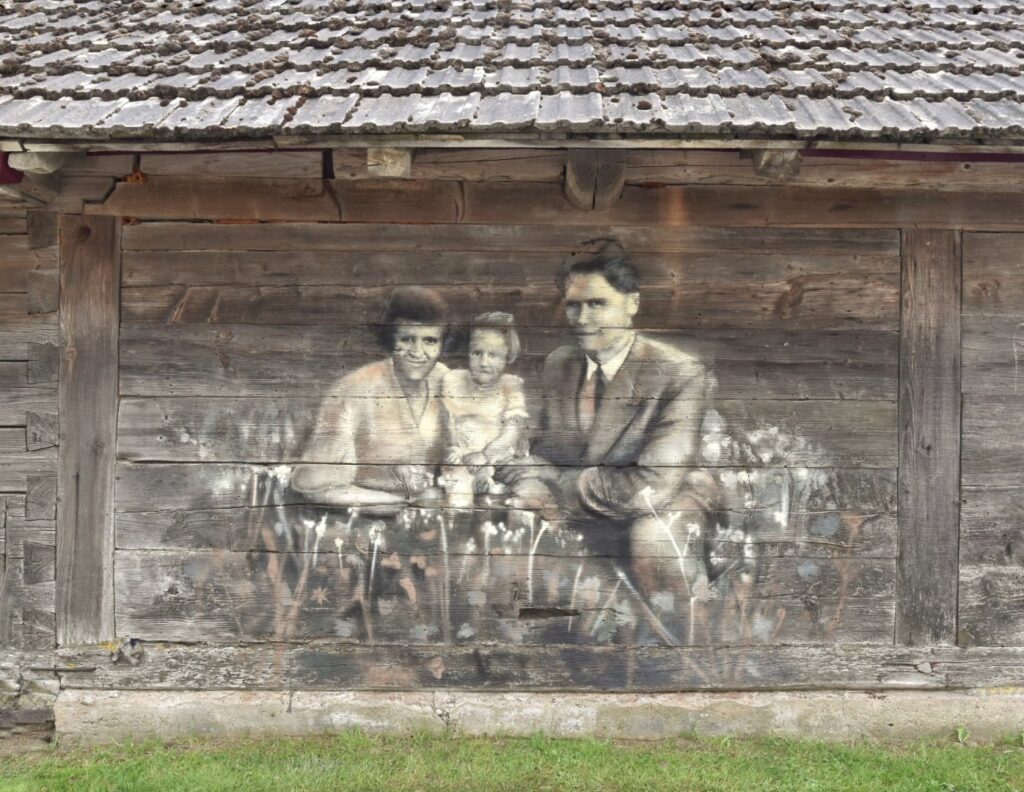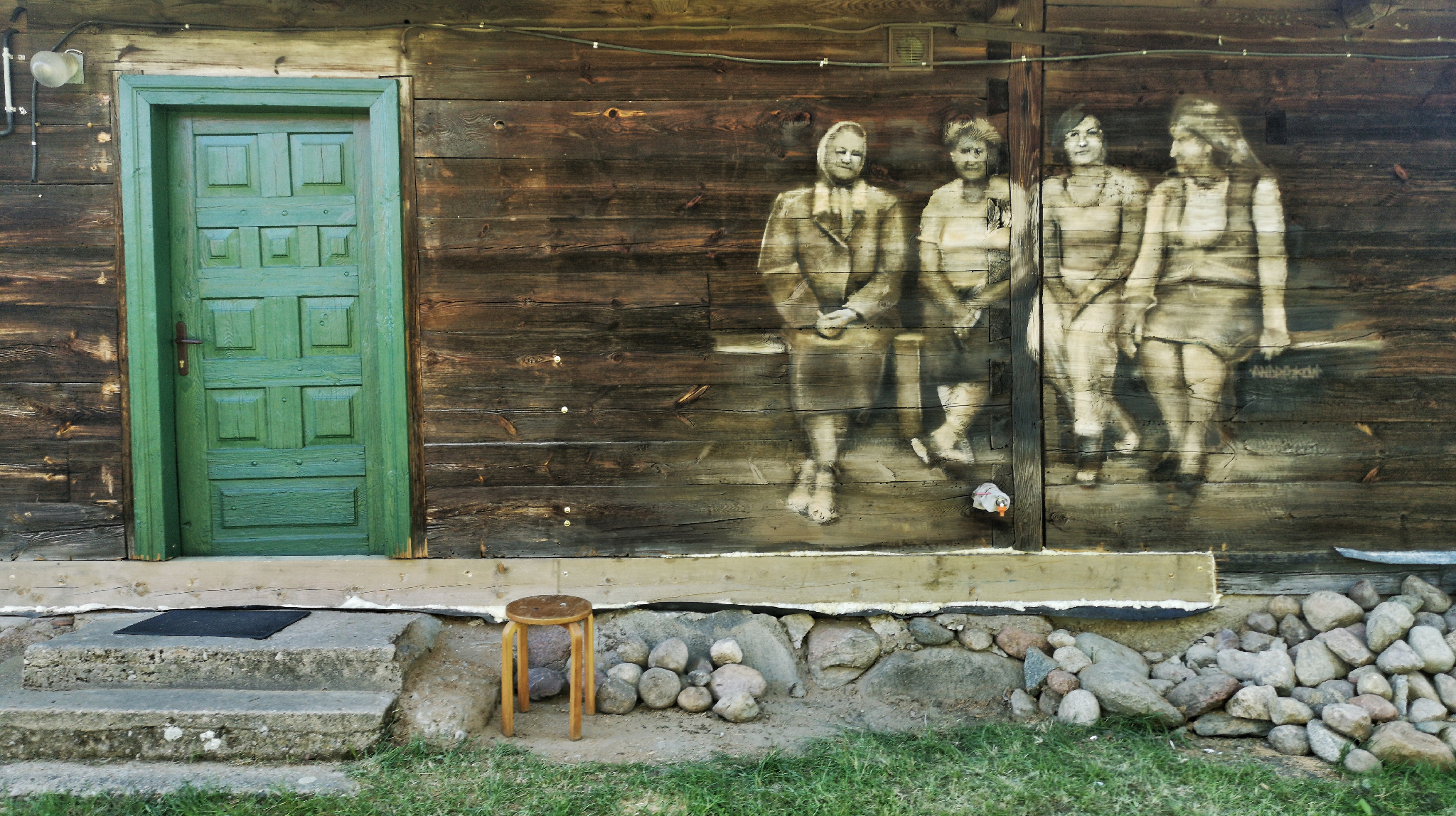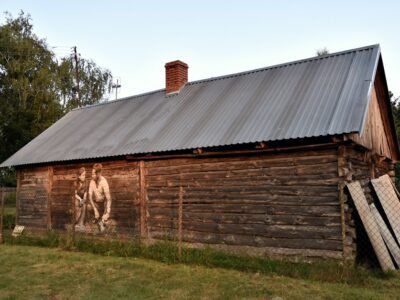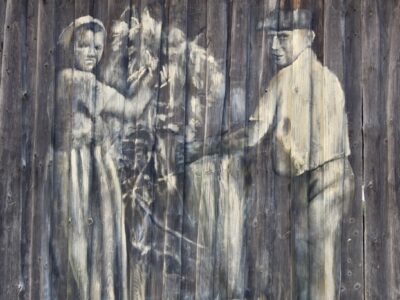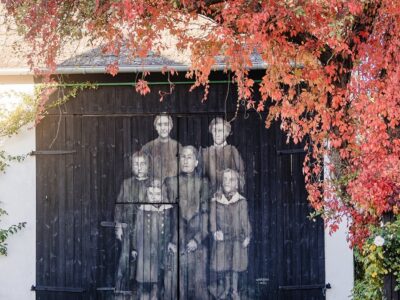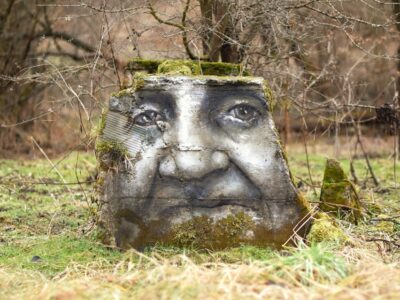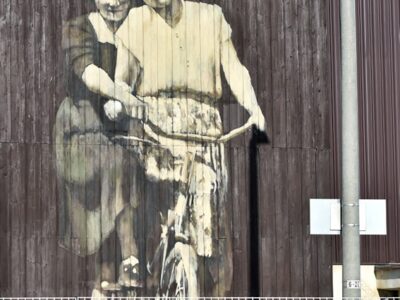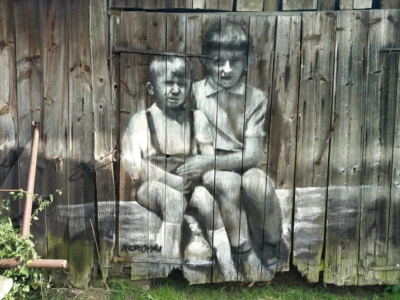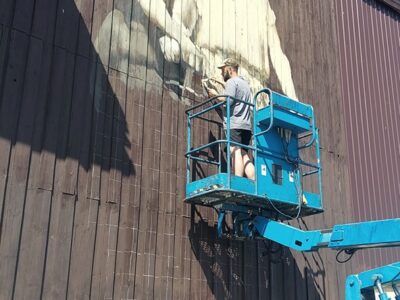Time treated the boards brilliantly, I am just adding the finishing touch – an interview with Arkadiusz Andrejkow
Arkadiusz Andrejkow is a painter and graffiti artist living in Sanok, whose unusual murals on old wooden buildings can also be found Podlaskie. What is the “Silent Memorial” project and what inspired the artist to create it? How do you paint on old boards? How did he come to Podlaskie with his work?
We invite you to an interview in which the painter reveals the secrets of his work and talks about inspirations and plans for the future.
Wood on old buildings is probably a good base for a painter?
Yes, it is one of my favourite substrates when it comes to my outdoor work. It is a very graceful material, very noble, interesting, rich in its variety, colours and shades. But at the same time, it is technically difficult to paint, because these substrates on barns or cottages huts, are very different. It is not always technically pleasant work, especially at the initial stage, where you have to draw everything out, arrange the characters. When I think about painting on old boards, on buildings in villages in places like Podlaskie, I believe that when I start painting on some barn or cottage, this painting already started to paint itself some time ago, much earlier than I did the first stroke. Because time has treated these boards very well, and I am, in fact, just completing the work.
Beautifully said. The texture of wood shines through from underneath the painting and the painting is not clear in itself, the board plays a role in it.
Yes, definitely. All the more so because I paint on white canvas a little differently, which is very rare for me, but if I had to compare the works done on cottages and barns with murals on traditional substrates, i.e. uniform brick or plaster walls, the background behind the figures on barns is as if taken care of. The old board is so interesting that I do not interfere too much anymore, I just put the characters there. On traditional, solid plaster walls, the composition is more extensive, because as a rule, you need to think about what’s behind the characters, whether to put them in some background, landscape or graphic form.
“Silent memorial” is unusual street art in the countryside. Tell me where the idea came from.
I started making the “Silent Memorial” in 2017. It goes back even further, because already at the Faculty of Art at the University of Rzeszów I was doing my diploma in painting inspired by old photographs. These were my family photographs and works on canvas. Before that I did my Bachelor’s diploma in Sanok, which also concerns old family photos – from then on old photographs of different families accompanied me as a source of inspiration in my work. I gave them up a little now and then, then I returned to them, but ever since I was a student, they inspired my canvas paintings. It wasn’t until 2017 that I started painting old pictures on barns. That’s one side of it – where the topic came from in the first place. And the other one is graffiti – the beginning of my work over 20 years ago is classic graffiti. Maybe because I live in Sanok – near Bieszczady, near Beskid Niski, beautiful forested and wild areas, I started looking for unusual places for my work. Not only around my neighbourhood, like some brick garages, where you need to get permission, prepare a wall, make a white base, haul paint and a lot of different materials. I needed to go out into the wild with just a few spray cans of paints in my backpack – somewhere out there on the outskirts of Sanok. I was looking for places under bridges, vacant houses, protruding fragments of concrete on old buildings and I started to do quick work with sprays, portraits of people whose photos I found on the Internet. I did not know who they were, and these were works without any historical context. I realized such works independently, and at some point, there were fewer and fewer walls… And every graffiti artist seems to have such a deviation, where the walls which are suitable for painting, seem to smile at them. At some point my eyes turned to barns, initially, of course, in Podkarpackie. I noticed that they are also a surface on which you can try to make a mural using the substrate as a fragment of the image.
And I almost hit the heart of the region. It seemed to me that Podkarpackie had a lot of wooden buildings, but when I saw how many there are in Podlaskie – barns, sheds, structures of various shapes, from different boards, worn and old, but in a cool way. I was fascinated.
What technique do you paint on boards?
I use facade paints. I paint with a brush, I also use sprays, but only a little, I mainly base on facade paints, resistant to external conditions.
Tell me how you got to Podlaskie with your work.
There was a buzz about my works on barns made in Podkarpackie, because the initial assumptions were that it would be a project carried out exclusively in my region, in my voivodeship. Thanks to the power of the Internet, the works began to spread quite quickly, people shared them, there was a big response. I started to receive private messages with proposals for painting in various regions, almost all over Poland. In the end, I went for Podlaskie. I did my first piece in Podlaskie in a place called Dubno. I could sleep in the cottage I painted, because the owner did live there, it was a rental. He commissioned me to paint it to create something unusual. I came to the Podlaskie, and it realised that I came to the right place. Podlaskie is also diverse, there is little of the region in the entire Voivodeship.
And I almost hit the heart of the region. It seemed to me that Podkarpackie had a lot of wooden buildings, but when I saw how many there are in Podlaskie – barns, sheds, structures of various shapes, from different boards, worn and old, but in a cool way. I was fascinated. I bragged about the work I had done on the Internet. I was on, let’s say, a spree – I had quick job to do near Warsaw and somewhere else… Later, when I left Dubno for Warsaw, a lady from Knorydy told me that she also wants to commission my work. I painted something near Warsaw and took a bus back to Podlaskie, and I did another job. That’s how it started rolling. Then there was Sitawka, where we worked with the Country Women’s Association for several years – there is a lot of works in a single village. In the last 4-5 years, I have been to Podlaskie several times a year.
We are very pleased. Still a question about the theme of your murals on boards. Most of the works depict people from old photographs. It’s like a “gallery of the forgotten”, ghosts of the past…?
Yes. It started with old photographs. When the concept of painting barns started to sprout, I did not think I would paint old photos of the inhabitants of these places. It seemed to me that these would be impersonal portraits, that it would not be anyone special, just a wrinkled face of an elderly person from the Internet. That these wrinkles will be nice to blend with wood knots and old boards. But I decided that it is worth trying more and asking, look for old photos in the place where I would paint. That’s how the concept was born. I painted the past inhabitants of the villages where a mural was created, and more often than not it was even the case that I painted the former members of a particular family of that farm – grandparents, parents, grandmothers. This is not always the case, but most often they are deceased family members of those people who live there now. The people who commission my work share these photos with me, so all the issues of designing were beyond me, because I was getting an object to paint and a photograph. Not everything worked or still works, but that is more or less what it is about.
A true memorial.
The concept is a commemoration, but not of the distinguished people who in other places are on monuments or plaques, but of the little heroes, people known in local communities, about whom hardly anyone wrote or mentioned anywhere. They were like silent heroes.
These works fit into your style – many of the characters in the paintings you paint on canvas are also blurred, worn away... Do you want to show our transience in this way?
For sure, subconsciously I show the transience of life and the fact that some situations are blurred, and we do not know when we may just not be there, we will not have this sharpness, we will not be visible. I was fascinated by the imperfection of photography, especially old or even contemporary photographs, so that there was a blur effect, preparing it in a graphic program or then in a painting form processing them so that these images would be further in a realistic form, but a little unreal. I have always been fascinated by portraits, but I wanted to approach it unconventional in various painting cycles.
Will the paintings on barns deteriorate over time? Do you plan to renew them?
They will deteriorate, I think, in an interesting way. It also depends on which side they are painted, how the sun affects them. If in summer days the sun shines for a long part of the day, then this piece will certainly deteriorate faster, but there are so many works all over the place, I will definitely go around and make corrections. For now, I still paint a lot, so despite the fact that the earlier ones are deteriorating, there are also new ones – the balance is preserved.
You leave it to nature.
Exactly so.
I am glad that the project lives on and has become a source of income, which certainly pleases you as an artist. I hope you continue to enjoy that new works pop up!
Thank you!
Conducted by
Joanna Buharewicz
Photos
Archive of Arkadiusz Andrejkow
Portrait photo: Grzegorz Kosmala

